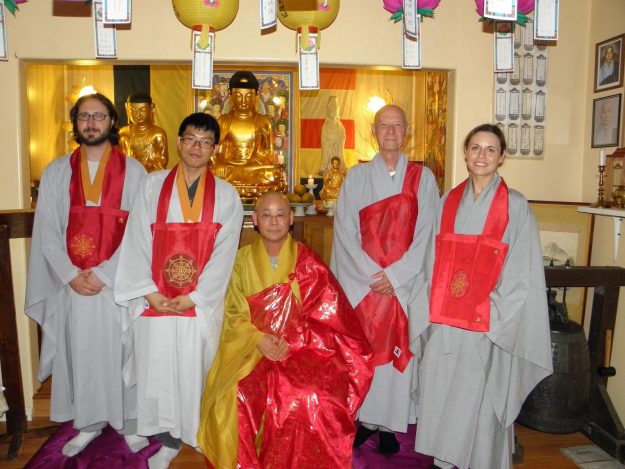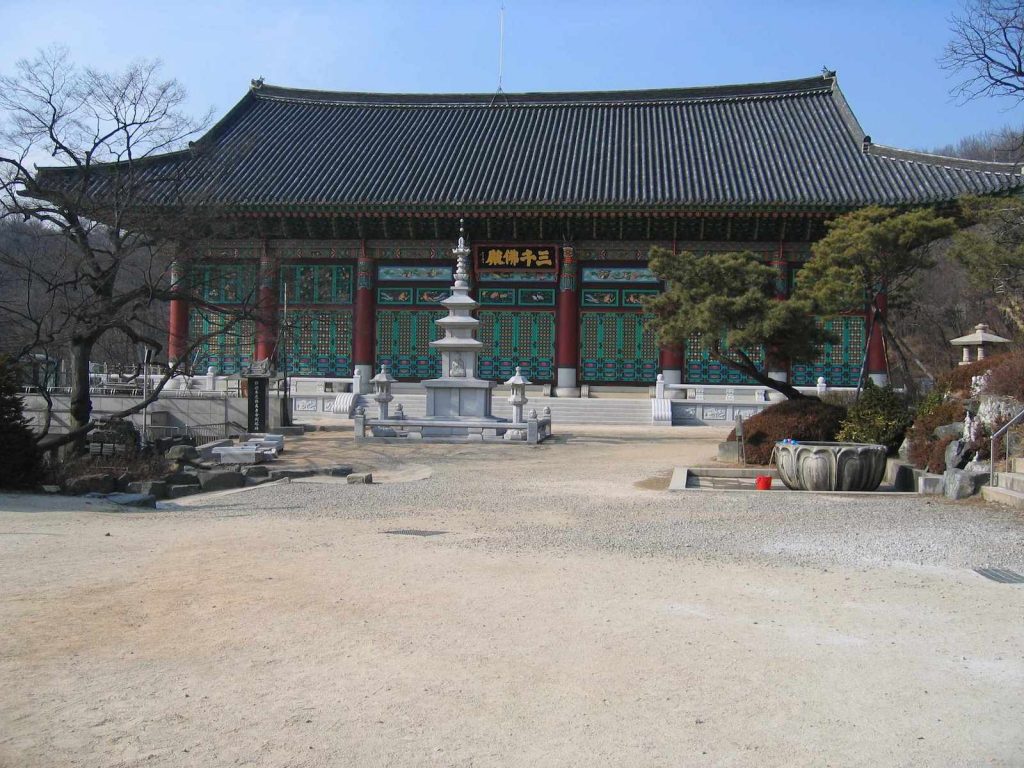A mixture of scents from Chinese, Indian, and Korean incense wafts in the cool southern California morning air of Bo Kwang Buddhist Temple in the Anaheim Hills of California. At first glance, the temple is a modest house in an unassuming suburban neighborhood, but beyond the entryway, one notices the interior of a Buddha hall in place of a living room. Every Sunday at 11 a.m., a monk sitting in front of an altar strikes a bronze bell while chanting in honor of buddhas and bodhisattvas. After the opening chants, the monk leads a dozen participants in the proclamations to seek refuge in the Buddhist sangha and teachings, followed by the chanting of the Great Compassion Dharani, Mahakarun dharani. The hour-long service continues with chants and mantras invoking dharma guardians and bodhisattvas, a recitation of the Heart Sutra, a dharma talk, and a final ringing of the dharma bell. Afterward, the sangha gathers in the same converted living room for the day’s highlight: a Korean Buddhist temple food lunch.
Sundays at Bo Kwang Temple resemble many Korean Buddhist weekly services, with one major exception—the temple is part of the Taego Buddhist tradition, a lesser-known order in Korea and abroad. The Taego Order is the second-largest Seon (C. Chan, J. Zen) order in Korean Buddhism (the Jogye Order being the largest). The founders named the order after the 14th-century Seon Buddhist master Taego Bo-u (1301–1383), which means “grand ancient.” The name is both a misnomer and a fitting title. While the Taego Order does indeed maintain older practices that the Jogye Order has long abandoned, the order itself is only a little over fifty years old.
Seon Buddhism
Since the Taego Order’s beliefs and practices are almost identical to the Jogye Order, the untrained eye will find it hard to spot the differences beyond the Taego cleric’s signature red outer robes (K. gasa). Both are considered Seon, or “meditation” Buddhism, which gained a formidable following in Korea around the 11th and 12th century. When Buddhism came to Korea via Chinese clergy circa the 3rd century, forms of Mahayana Buddhism were becoming dominant in eastern Eurasia, and the literate, elite-centered tradition was concerned with scholastic interpretations of Mahayana Buddhism’s enormous corpus of texts and philosophical schools, such as Yogachara and Madhyamaka. But when Seon orders became dominant, practices and scripture from other forms of Mahayana Buddhism, such as Pure Land beliefs, dharani recitation (a mantra-like recitation), and the study of the Avatamsaka Sutra, were integrated. Though other practices were accepted, Seon centered on seated meditation and contemplation of the hwadu (C. huatou), the primary phrase of a gongan (J. koan). Practicing these together was considered the most efficient path to awakening. While other forms of Korean Buddhism, such as Cheontae (C. Tiantai; J. Tendai), have persisted or been revived in the present, Seon remains dominant. Both the Jogye and Taego orders regard themselves as successors to Linji Yixuan (?-866) (K. Imje Euihyeon; J. Rinzai Gigen), who purportedly utilized practices such as hwadu and random acts of shouting and hitting to induce awakening.
Integrated with Shamanism
Many notable practices distinguish the Taego order, however, including its acceptance of Korea’s indigenous spirituality. While worship of mountains, Seven Stars (the Big Dipper), and the dragon king have long featured in Buddhist schools across eastern Eurasia, in Korea the specifics often depend on local shamanic traditions. Laywomen in Korea tend to be the most avid participants in Buddhist services, and their interest in spiritual and this-worldly benefits has influenced what rituals are emphasized and what they mean. On South Korea’s Jeju Island, for example, some Buddhists identify Seven Stars fertility deities as the island’s snake deities and emphasize Jeju’s native Mt. Hallasan mountain god. While the Taego Order publicly accepts the Jogye Order’s position on “modernizing” Buddhism and has almost the same simplified rituals, the Taego clergy may be less inclined to impose orthodoxy on their lay constituents and more inclined to adopt local beliefs relevant to their communities.
Marriage
The Taego Order’s most distinguishing characteristic within Korean Buddhism, though, is that many monks are married householders. This quirk of the Taego Order stems from a complicated early 20th-century history of Japanese colonial-era policies and post-liberation nationalistic policies. Since the time of the monk Jinul (1158-1210), founder of the Jogye Order, Korean Buddhism has emphasized strict monastic celibacy. While married clergy was not uncommon in Korean history, celibacy remained ideal for monks until the period of Japanese colonial rule (1910-1945). In 1910, the Japanese Government-General issued Order 7, which mandated temple reforms such as legalized marriage and meat consumption for monks and other practices standard in Japanese Buddhism. Some reform-minded monks accepted these reforms as necessary to modernize Korean Buddhism, but many remained steadfastly opposed.
After liberation and the Korean War, the authoritarian administration of President Syngman Rhee, a devout Protestant Christian, utilized Korean ultranationalism to purify practices deemed colonial or premodern legacies. On May 20, 1954, President Rhee mandated that all married monks be expelled from Buddhist temples and monasteries, disenfranchising many clergy who had already married. Disputes and physical conflicts with the national police and thugs hired to evict married clergy roiled the Korean Buddhist world. Some Buddhists resisted the decree, while others who supported celibacy took advantage of a newfound alliance with the state. After a political coup in 1961, the new president, Park Chung Hee, attempted to negotiate a settlement between the two sides, but the state ultimately sided with the more politically-connected celibate clergy. In 1970, a group of married clergy and allied celibate monks formally established the Taego Order and petitioned the national government for official recognition.
Today, Taego clergy consider marriage in light of the enlightened lay householder Vimalakirti, simply another way to follow the bodhisattva path. Venerable Jongmae, who founded the Bo Kwang temple in 1987 and presides over Taego’s US-Europe Overseas Parish, regards married clergy as an advantage in the ever-changing 21st century, where monasticism across all faiths seems to be in crisis. A pioneering figure in the Taego Buddhist overseas mission to make the Korean faith compatible with local cultures, Jongmae considers married clergy better prepared to respond to the needs and experiences of lay life. His emphasis on spiritual fulfillment in the mundane is not unique: many Taego members in Jeju prefer clergy that understand their everyday concerns.
Temple Management
Yet another distinguishing feature of the Order is that many Taego temples are privately operated and often locally managed, independent of a central authority in Seoul. Where Jogye abbots and abbesses may transfer to another temple after five years or so, it is not unusual for an abbot or abbess at a Taego temple to remain for decades or even pass a temple to a dharma or familial heir. For example, venerable Su’am (b. 1940) at Geumbung Temple in northeastern Jeju inherited his position from his father, who famously harbored people seeking refuge during the 1948-1954 April Third massacres.
Because Taego temples are often privately managed and headed by clergy from the region, the clergy are more accommodating to local beliefs. Clergy at Taego temples like Jang’an Temple and Borim Temple in Jeju City, for example, do not shy from openly accepting the distinct shamanic-influenced spirituality of their congregations. They may perform annual rites by the seashore to Jeju’s sea god Yowang and the patron god of the island’s central mountain Hallasan at ancient shamanic shrines. A common refrain among Buddhists in Jeju is that whoever goes to a Buddhist temple goes to a shamanic shrine and vice versa.
The Japanese and North American-European temples are a little different. While similarly autonomous and adaptable, they all adhere to general ritual standards set by head temples in Korea. Some rules, such as more relaxed meditation retreat requirements, are modified to best fit the North American and European contexts; and similar to Jeju, Japanese temples allow elements of indigenous religions or may reduce other barriers to enter the Taego Order. Venerable Jongmae has suggested that this willingness to accept flexibility shared across the Taego Order’s various branches and having married clergy account for the Taego Order’s modest successes in the United States, Europe, and Jeju Island.
Social Engagement
While the early Taego Order comprised only a handful of temples since its 1970 founding, the number of Taego temples has increased to around 4,000 worldwide, of which six are major monasteries. The Taego Order in North America and Europe has grown from a small core membership of thirteen clergies in 2007 to sixty-two in 2022, with representation in the US, Canada, the UK, Italy, Finland, Germany, Austria, Poland, and Hungary.
Venerable Jongmae argues that another part of the order’s success is emphasizing social engagement that doesn’t privilege monasticism. Taego clergy depend on their day jobs rather than on community donations for their living. Many members seek jobs that merge Buddhism with everyday life, emphasizing the precept of Right Livelihood, such as hospital and army chaplains, veterinarians, and academics. Because the Taego Order in Japan, the US, and Europe do not depend on community donations and clergy have regular day jobs, the overall trend of decline in visitors to institutional religious establishments in much of the developed world has had limited impact. The history of the Taego Order on both hemispheres is thus one of resiliency and a willingness to adapt to a rapidly changing world.

Thank you for subscribing to Tricycle! As a nonprofit, we depend on readers like you to keep Buddhist teachings and practices widely available.
